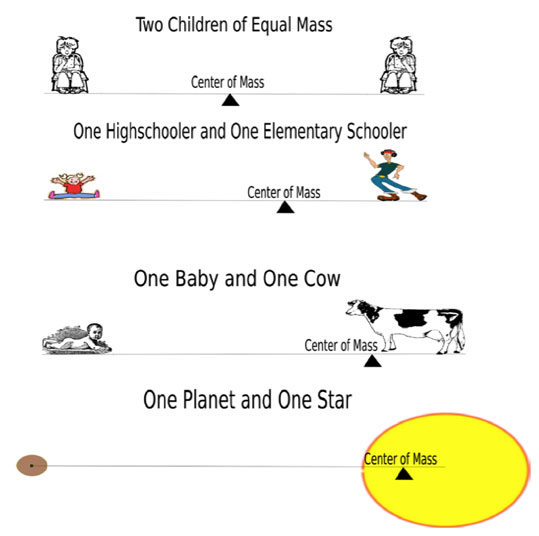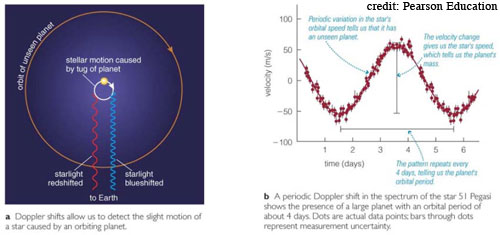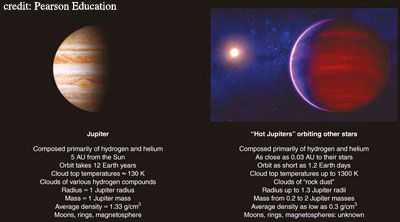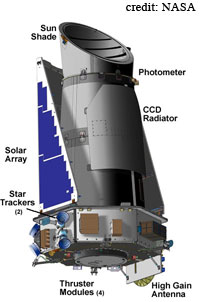
Extrasolar PlanetsExtrasolar Planets
SUMMARY: An extrasolar planet, or exoplanet, is a planet outside of our solar system that orbits a star other than our Sun.
Detection Methods
General Properties of Known Exoplanets
Comparing Exoplanets to Planets in our Solar System
Kepler Mission
Related Links
Related Lessons:
Space Travel Guide
Detection Methods
Swiss astronomers Michael Mayor and Didier Queloz discovered the first exoplanet in 1995. Since then, the number of verified exoplanets has surpassed 200. There are a few different methods scientists use when trying to detect extrasolar planets.
Detection Methods:
- Direct Evidence:
- Images of the planet
- Spectra of the planet
- Indirect Evidence:
- Doppler technique
- Transits
Direct evidence of exoplanets is very difficult to obtain. Think about the pictures we have of Pluto as taken from Earth. The best pictures we have show Pluto as a very small, round blob. It's hard to take a good quality picture of something that is so far away. Pluto orbits, on average, about 40 times farther from the Sun than Earth. That's pretty far. Now think about a planet that is 4 million times farther from our Sun than we are. You can imagine how tough it is for us to get a picture of something that far away. Not only are they really far away, but planets are really dim compared to their parent stars so they're really hard to see. Indirect observations (such as the Doppler technique, transits, and eclipses) are much more commonly used when searching for exoplanets.
The Doppler technique is a good method for discovering exoplanets. It uses the Doppler effect to analyze the motion and properties of the star and planet. Both the planet and the star are orbiting a common center of mass. This means that the star and the planet gravitationally attract one another, causing them to orbit around a point of mass central to both bodies. It is like trying to perfectly balance a large child and a small child on a teeter-totter. If the teeter-totter is suspended in the center, the larger child will be on the ground, but if you move the larger child very close to the center, both children will be in perfect balance. If we could rotate the children around each other, both the large child and the small child orbit a common center of mass.
SHOW ME THE MATH:
THE DOPPLER EFFECT

In our solar system, all bodies orbit a common center of mass, including the Sun, but the Sun is so large in comparison to the planets, the center of mass actually lies inside the Sun! This makes the Sun seem to wiggle back and forth, and the spectrum of the Sun shifts back and forth as well. We search for this spectral shift in other stars to determine if there are one or more planets orbiting that star. When the star moves toward us, the light emitted has a shorter wavelength, so we say its spectrum is blue shifted. When it is moving away from us, the light has a longer wavelength, so we say its spectrum is red shifted. While the Doppler technique is most widely used for detecting extrasolar planets, it is best suited to look for very massive planets orbiting close to their parent star. This is because the parent star will wiggle more with a large planet nearby, thereby creating a larger and more easily detectable spectral shift. Most planets discovered around other stars have been very massive and orbit extremely close to their parent star.
Another indirect observational tool is called a transit. This is when a planet crosses in front of its parent star, temporarily decreasing the star's brightness by a small amount. This method allows scientists to calculate the density and size of the planet with respect to the size of the star.
Although these methods give us an idea of size, distance, and orbital period of the planets, they can't really give us any concrete information about the planet. Direct observation is a better tool than indirect, but because these planets are so far away and essentially hidden from view due to how small and dim they are compared to their parent stars, direct observation is often impossible.
General Properties of Known Exoplanets
Certain characteristics are common in most known exoplanets, as well as the stars they are orbiting. Most of the stars that host planets are main-sequence stars similar in spectral class to our own Sun. Most known exoplanets are fairly massive. This doesn't mean that Earth-sized exoplanets don't exist—remember, our detection methods favor finding massive planets orbiting close to stars. Some even orbit more closely than Mercury orbits the Sun. Unlike the nearly circular orbits of the planets in our solar system, most exoplanets exhibit largely eccentric orbits. Most of the known exoplanets are gaseous, similar to the giant planets in our solar system, although some of the smaller exoplanets found show signs of rockier, terrestrial compositions.
SHOW ME THE MATH:FINDING MASSES OF
EXTRASOLAR PLANETS
Comparing Exoplanets to Planets in our Solar System
Scientists have found that most known exoplanets share many similarities with the jovian planets in our solar system, such as size, density, and composition. Exoplanets are probably made of hydrogen and helium gas. Since these planets orbit close to their stars, their temperatures are probably much higher than temperatures on the jovian planets. If Jupiter orbited as closely as some of these exoplanets, theoretically it should actually be larger in radius because Jupiter's gas would heat up and expand. Confirming this, we have observed a planet around star HD209458 that looks just like a puffed up Jupiter. Scientists have dubbed these close-orbiting gaseous planets "hot Jupiters". Hot Jupiters probably have cloud layers, but such high temperatures would mean that different elements could condense. It would be far too hot for ammonia, methane and water to condense, like they do in Jupiter's atmosphere. These high temperatures might even allow for clouds made from materials we would normally think of as solids on Earth (for example, some metals).
With the landslide of exoplanet discoveries in the last decade, scientists have begun to question the theories we have about the formation of our own solar system. How is it that the planets in our solar system have such different characteristics than the extrasolar planets we have found? The nebular theory says that the inner planets are rocky because rocks and metals condense at high temperatures, while the outer planets are mostly gaseous because hydrogen compounds condense at lower temperatures, thus farther from the Sun. Hot Jupiters, like so many of the known exoplanets, should not exist so close to their stars according to our model of formation, so how did they form? Although it is not known for sure, one possibility is that these hot Jupiters formed farther from their parent star and migrated inward to a smaller, more eccentric orbit.
The knowledge of other planetary systems certainly puts a glitch in our theory of formation, but it doesn't necessarily mean it's wrong. Our theory works for us, but it is just that: a theory. It is very specific to what we have found through centuries of research, and the centuries of research to come will surely change the way we perceive our world and the universe.
Kepler Mission*
The majority of extrasolar planets detected thus far are gas giants, like the outer planets in our solar system. Scientists are certain that life, as we know it, could not exist on the outer planets in our solar system. The challenge now is to find terrestrial exoplanets that may be capable of sustaining life. Scheduled for launch in 2009, the Kepler Mission is designed to search our region of the Milky Way for smaller, Earth-sized exoplanets in or near the habitable zone of their parent star. Kepler will stare at a single portion of the sky in the Cygnus region along the Orion arm for its entire mission with hopes of detecting hundreds more exoplanets.
There are certain conditions necessary to make a planet habitable, and there are a few key factors that influence these conditions. The size and temperature of the star, as well as the orbit of the planet, largely determine the condition of having liquid water on the surface. Planets too close to a star are so hot that any water on the surface would boil away, while planets too far from a star are so cold that any liquid water freezes. The size and mass of the planet determine whether or not it can sustain an atmosphere. Smaller planets may not be massive enough to have the surface gravity necessary to retain an atmosphere. Other factors, such as the composition of the atmosphere, will influence the temperature of the planet and the type of protection from various forms of harmful radiation.
In order to find planets, Kepler will use the detection method known as a transit. A transit is an event in which a planet passes in front of a star as seen from Earth. Compared to a larger planet, transits by terrestrial-sized planets produce a small change in the brightness of the star. This change in brightness lasts only a few hours, depending on the distance between the planet and the star. We know a planet is causing the change in brightness if the change is periodic, which means that it happens again and again on the same time period.
The main Kepler instrument is a telescope called a photometer, or light meter, with a very large field of view. It will stare at the same star field for the entire mission and continuously and simultaneously monitor the brightness of more than 100,000 stars. If Earth-size planets are common, Kepler should detect hundreds of them.
Want to know more about the Kepler mission? You can learn more about the Kepler mission from the official home page.
Links to lists of known extrasolar planets:
Astrobiology Web
California & Carnegie Planet Search
Johnston's Archive: Extrasolar Planets and Brown Dwarfs





